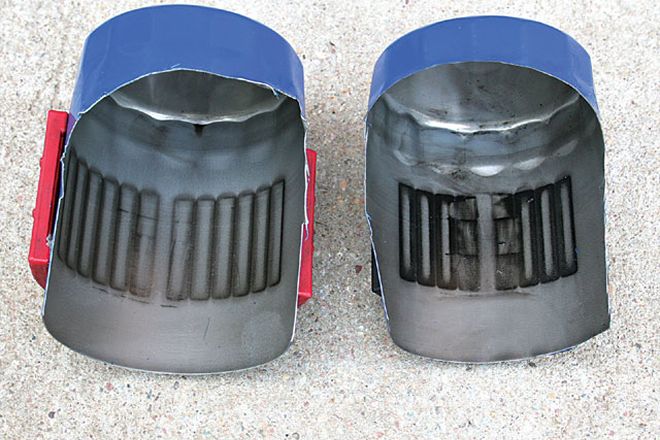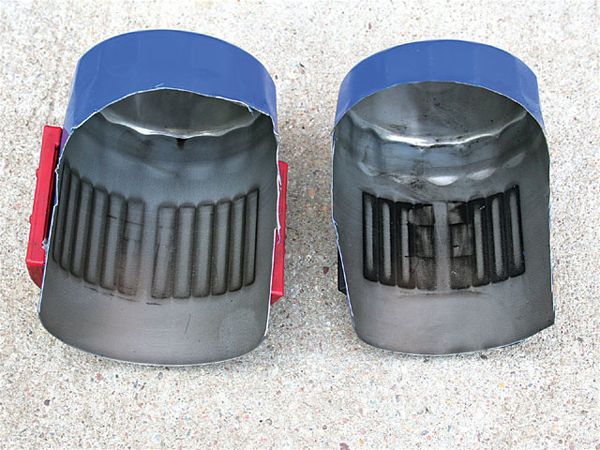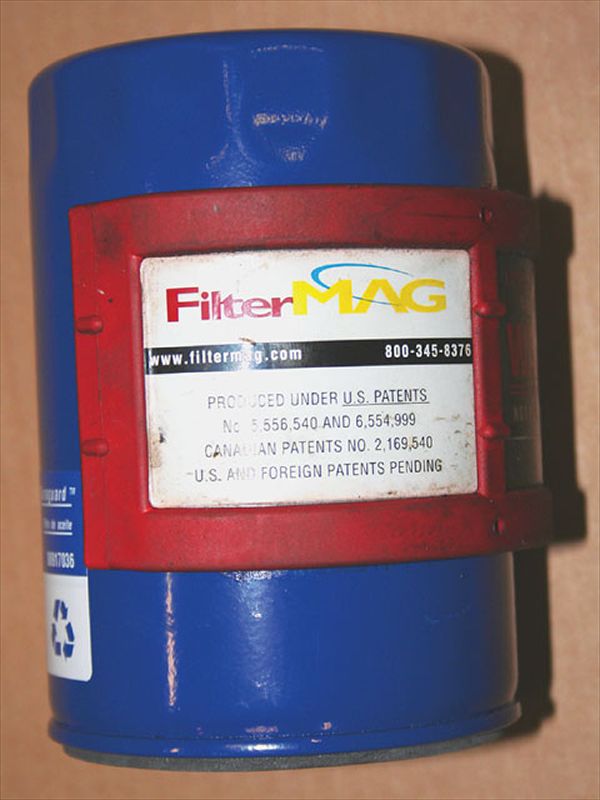
Oil and filter changes are important in maintaining a long engine life. In fact, changing both of them is probably one of the most important maintenance items on your vehicle.
Sure, you've heard that oil never wears out, and that's probably true, but the additive package that the manufacturer uses does wear out. Additive package? Yep, that magic stuff that controls the oil's viscosity, foaming, sludge buildup, high-pressure wear, cold start-up lubrication, and trash-carrying ability all in time wears out. And, no, you can't just go to your local parts store and periodically add some "mechanic in a can" and expect things to be good and great again. For one, what you add may not be compatible with the oil's present additives, and secondly, what you add may be too much or too little.
 The filter on the left came from a Duramax diesel with 40,000 miles, the one on the right from a small-block Chevy with 30,000 miles. You can readily see how the individual magnet elements have trapped and held the small metal particles. While small, you can easily feel the grit when rubbed between your fingers.
The filter on the left came from a Duramax diesel with 40,000 miles, the one on the right from a small-block Chevy with 30,000 miles. You can readily see how the individual magnet elements have trapped and held the small metal particles. While small, you can easily feel the grit when rubbed between your fingers.
The second reason for changing the oil and filter is to get rid of the accumulated dirt. Oh, but isn't that the filter's job? Sure it is, but the filter is a compromise. While its job is to gather up and trap dirt and metal particles, it also has to be able to continuously move oil through the filter media without restricting the amount of flow. The typical oil filter will catch particles down into the 25- to 40-micron range.
What's a micron? Well, it's nothing more than a unit of measurement: 0.001 inch = 25 microns. For instance, for comparison purposes, a human hair is about 75 microns thick, table salt is 100 microns, a red blood cell is 6 microns, and everyday household dust is 50 microns.
Some years back, Detroit Diesel did some wear tests and found that abrasive engine wear was reduced by 50 percent when switching from a 40-micron filter to a 30-micron filter, and by 75 percent when a 15-micron filter was used. Yes, manufacturers could make a filter that traps particles in the oil down into the 15-micron range and below, but the big problem is that these filters will plug up quite quickly and become so restrictive that the oil pump's bypass valve will open and any filtration will be lost. While the 25- to 40-micron filter does a great job, what about particles below this size? Yes, they are there and are damaging to the engine.
Some of these smaller particles come from metal being scuffed off during cold engine start-up and during hard use. If the oil was a perfect lubricant and maintained a perfect cushion between metal-to-metal parts, then in theory an engine would never wear out. Well, we know that just doesn't happen. Why? Well let's take the crankshaft and rod-bearing clearance for an example, and say the cold clearance is 0.002 inch. Now that's the difference between the journal size and the bearing inside diameter. That puts the actual clearance between metal on metal at 0.001 inch or 25 microns. It's a given that when an engine gets hot, components expand; so in theory, the clearance actually gets to be less. In reality, there are some parts, like timing chains, where the clearance is even less-a lot less. An oil film is generally about 10 microns thick. Now, if particles as large as 40 microns are traveling around in the oil, they're actually larger than the clearance on the crankshaft. Moving through the engine, these small particles work as abrasive cutters, continually doing more and more damage. The most common way to get rid of them is by regularly changing the oil. But just how many do we get rid of?
I wanted to find out, so my first step was to install a magnetic drain plug in the engine's oil pan. And yes, at the next oil change I found a bit of metal residue on the magnet. But was I catching all the metal in the engine? I doubt it. After thinking about it a bit, I figured the only metal I was really catching was that in the immediate vicinity of the drain plug.
OK, what about putting a large magnet right on the oil filter, since all the engine oil would be going past it? After some searching, I found a pretty strong magnet that fit the bottom of the filter. After the next oil change, I cut the filter apart, doing my darnedest to keep cutting debris away from the end with the magnet. Guess what I found? Not much-just a slight bit of discoloration that was easily wiped away and, in reality, didn't feel gritty at all. Could be I was wrong? Maybe there wasn't as much metal in the oil as I thought.
 You can see that the Filter Mag wraps itself nearly halfway around the filter. These are really powerful magnets that make it in some cases difficult to remove. One thing is for sure-it will never just fall off.
You can see that the Filter Mag wraps itself nearly halfway around the filter. These are really powerful magnets that make it in some cases difficult to remove. One thing is for sure-it will never just fall off.
Then I discovered a product called Filter Mag (800/FILTER-MAG, www.filtermag.com). After a phone conversation with President Robert Fowler, I found the errors in my testing. He explained that most magnets can't pull out and hold the metal particles as the oil flows by them. It's only stagnant oil that will release the metal particles to the magnet, and when the oil again starts moving, the high flow washes off and pulls the metal back into the oil. The more I thought about what he said, the more sense it made. He went on to explain how "the Filter Mag uses a focused magnetic field that amplifies its powerful neodymium magnets to generate the force needed to hold particles as small as 2 microns against the oil flow."
Sounded good to me, so I ordered up a couple of Filter Mags-one for my Duramax diesel and one I could swap between my two Jeeps and diesel tractor. I also ordered a filter cutter. It's kind of like a large can opener with a cutting wheel so you don't add any metal shavings.
When I cut the filter open on the Jeep (30,000 miles on a small-block Chevy, which gets an oil and filter change about every 2,000 miles), I was absolutely amazed at the amount of metal that the magnet had caught. Running my fingers across it and then rubbing them together gave a very positive feeling of grit. Actually scary! The diesel tractor and Duramax diesel didn't show half as much, but there was still enough metal to be concerned with.
The V-8 in the Grand Cherokee? Well, that test wasn't very conclusive, but again I found metal where the magnet had been attached. No, the magnet didn't fall off. The problem was just the opposite-I had a hard time getting it off the filter! There wasn't enough clearance between the block and the filter for the magnet as the filter was being unscrewed. I had to pry the magnet off, which wasn't an easy job. Fighting between the control arms and the aftermarket headers, my hands almost came out the loser before I got the magnet off.
While it's not necessary to cut the filter open each time, it's really not a bad idea. Especially so on a performance engine, as it might be a quick way to determine the mechanical condition of the engine. Any additional metal particles over those observed the previous time may be an indicator of a camshaft lobe going flat, a chipped lifter, valve-stem wear, a broken piston ring, or timing gear/chain wear.
Opinion: I really think the Filter Mag is worth the money. Any time you can visually see caught metal particles, you know there has to be a benefit, which is longer engine life.
If you're trying to figure out what is the best oil filter, check out http://minimopar.knizefamily.net/oilfilterstudy.html. While a bit outdated, it is still the best oil-filter test publication that I have ever encountered.